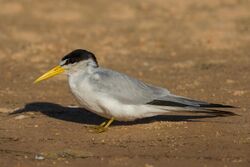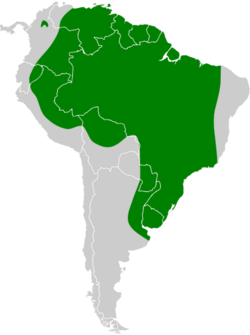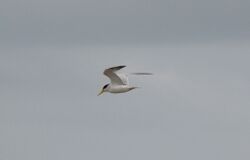Biology:Yellow-billed tern
| Yellow-billed tern | |
|---|---|

| |
| Scientific classification | |
| Domain: | Eukaryota |
| Kingdom: | Animalia |
| Phylum: | Chordata |
| Class: | Aves |
| Order: | Charadriiformes |
| Family: | Laridae |
| Genus: | Sternula |
| Species: | S. superciliaris
|
| Binomial name | |
| Sternula superciliaris (Vieillot, 1819)
| |

| |
| Synonyms | |
|
Sterna superciliaris | |

The yellow-billed tern (Sternula superciliaris) is a small seabird found in South America. It is a species of tern in the family Laridae. It is found in Argentina , Bolivia, Brazil , Colombia, Ecuador, French Guiana, Guyana, Panama, Paraguay, Peru, Suriname, Trinidad and Tobago, Uruguay, and Venezuela. Its natural habitats are rivers, swamps, and freshwater lakes.
Description
It measures approximately 23-25 centimeters in body length and weighs 40-57 grams.[2] It has a yellow beak and feet, silvery grey wings and white underbody and forehead. Its crown, nape, and eyeline are black. Juveniles are brown and white without the black cap.[3]
Nesting
It frequently nests alongside colonies of the large-billed tern (Phaetusa simplex) and the black skimmer (Rynchops niger).[4] The yellow-billed tern breeds from August to December on sand banks and island beaches. Non-breeding season habitats include coastal lagoons, river mouths, and rice fields.[5] Their nests consist of shallow scrapes in the sand. Most commonly a clutch contains 2 eggs, but the yellow-billed tern can lay anywhere between 1–4 eggs.[6] The incubation period is approximately 24 days. Nests are usually formed very close to each other.[4] Terns aggressively defend their nests from predators, and other species such as the sand-colored nighthawk (Chordeiles rupestris) have been known to nest among tern colonies to take advantage of this anti-predator behavior.[7]
Feeding
The yellow-billed tern forages during the day, mostly on small fish, shrimp, and insects.[2] It feeds by hovering and picking fish from surface waters.[3]
References
- ↑ BirdLife International (2016). "Sternula superciliaris". IUCN Red List of Threatened Species 2016: e.T22694679A93462603. doi:10.2305/IUCN.UK.2016-3.RLTS.T22694679A93462603.en. https://www.iucnredlist.org/species/22694679/93462603. Retrieved 17 November 2021.
- ↑ 2.0 2.1 Gochfeld, M., Burger, J., Garcia, E.F.J. & Boesman, P. (2018). Yellow-billed Tern (Sternula superciliaris). Handbook of the Birds of the World Alive.
- ↑ 3.0 3.1 Renaudier, A. and Claessens, O., 2014. Field identification of Least and Yellow-billed Terns: experience from French Guiana. Neotropical Birding, 15(1), pp.22-32.
- ↑ 4.0 4.1 Zarza, Rebecca; Cintra, Renato; Anciäes, Marina (December 2013). "Distribution, Abundance and Habitat Selection by Breeding Yellow-billed Terns (Sternula superciliaris), Large-Billed Terns (Phaetusa simplex) and Black Skimmers (Rynchops niger) in the Brazilian Amazon". Waterbirds 36 (4): 470–481. doi:10.1675/063.036.0404.
- ↑ Yellow-billed Tern (Sternula superciliaris), In Neotropical Birds Online (T. S. Schulenberg, editor). Cornell Lab of Ornithology, retrieved from Neotropical Birds Online: https://neotropical.birds.cornell.edu/Species-Account/nb/species/yebter2
- ↑ Lesterhuis, Arne Jent; Clay, Robert P.; Smith, Paul (1 November 2017). "Status and distribution of the suborder Lari in Paraguay, including new country records". Revista Brasileira de Ornitologia 25 (2): 128–136. doi:10.1007/BF03544389. ISSN 2178-7875. http://www4.museu-goeldi.br/revistabrornito/revista/index.php/BJO/article/view/25209.
- ↑ Groom, Martha J. (June 1992). "Sand-Colored Nighthawks Parasitize the Antipredator Behavior of Three Nesting Bird Species". Ecology 73 (3): 785–793. doi:10.2307/1940157.
Wikidata ☰ Q1269049 entry
 |


